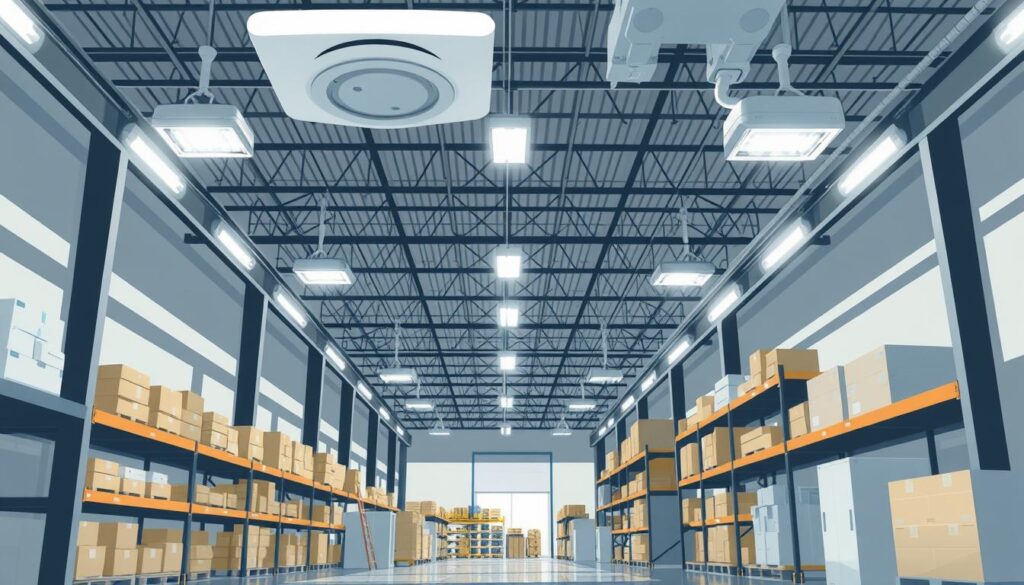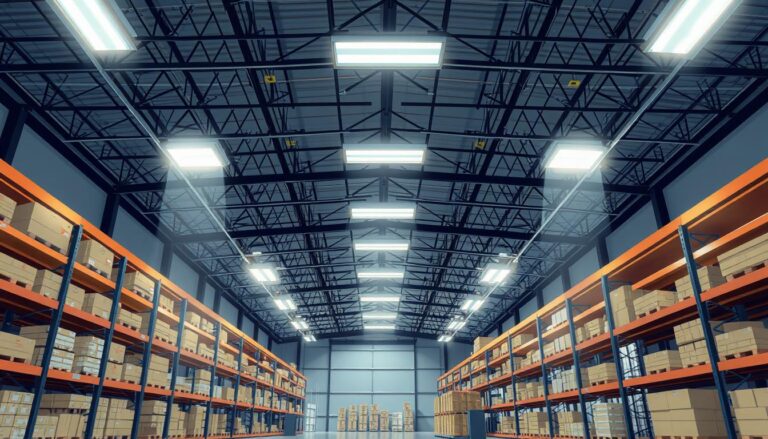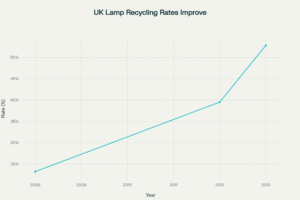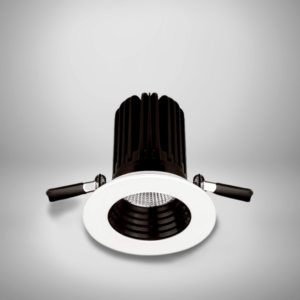Did you know that LED lights can slash energy consumption by up to 75% compared to traditional lighting in warehouses1? This statistic highlights the transformative power of automated lighting solutions for warehouses. We will explore how these systems are revolutionising warehouse operations across the UK.
Warehouse lighting automation is now a necessity in today’s competitive business landscape. Smart lighting systems for warehouses offer numerous benefits, including enhanced energy efficiency, improved safety, and increased productivity. These systems utilise advanced technology to optimise illumination based on occupancy, daylight availability, and specific task requirements.
The impact of automated lighting solutions for warehouses goes beyond energy savings. High-bay LED fixtures, designed for tall storage racks and open spaces, provide focused, high-intensity lighting. This significantly improves visibility and safety1. These fixtures can also last up to 100,000 life hours, which is 5-10 times the lifespan of traditional lighting options2.
Implementing warehouse lighting automation is more than just installing new lights. It involves creating an intelligent ecosystem that adapts to your warehouse’s unique needs. From motion sensors that reduce energy consumption during low-activity periods to smart control systems that provide real-time control over lighting zones, these solutions offer unparalleled flexibility and efficiency13.
In this guide, we will dissect the intricacies of automated lighting solutions for warehouses. Our aim is to assist you in making informed decisions to illuminate your path to success. Let’s shed light on the future of warehouse operations together.
Understanding Automated Lighting Solutions
Automated lighting solutions are transforming warehouse operations, introducing intelligent controls that boost efficiency and safety. These systems adjust lighting levels and patterns dynamically, responding to various environmental factors within the warehouse.
What Are Automated Lighting Solutions?
Automated lighting solutions represent advanced systems aimed at optimising energy-efficient illumination in warehouses. They employ cutting-edge technology to manage lighting based on occupancy, time, and natural light levels. This approach significantly minimises energy waste by ensuring lights are only active when and where necessary4.
Key Components of Automated Systems
The fundamental components of automated lighting systems include:
- LED fixtures: These are the energy-efficient light sources that underpin modern warehouse lighting
- Motion sensors: They detect movement to activate lights in specific areas
- Daylight harvesting sensors: These adjust brightness based on available natural light, optimising energy consumption5
- Centralised control units: They manage the entire system, enabling thorough monitoring and adjustments
These components collaborate to establish a responsive and efficient lighting environment. For example, in racking areas, specialised fixtures with long, narrow beam angles ensure optimal illumination for these critical spaces5.
| Component | Function | Benefit |
|---|---|---|
| LED Fixtures | Provide energy-efficient illumination | Reduced energy consumption |
| Motion Sensors | Activate lights based on movement | Improved safety and energy savings |
| Daylight Harvesting Sensors | Adjust lighting based on natural light | Optimised energy use |
| Centralised Control Units | Manage overall system | Enhanced control and monitoring |
By integrating these components, automated lighting solutions provide unparalleled control over warehouse illumination. They can be programmed to adapt to specific layouts, operational schedules, and task requirements. This represents a significant leap forward from traditional manual or timer-based systems54.
Benefits of Automated Lighting in Warehouses
Automated lighting solutions bring numerous advantages to warehouse operations. These systems transform the way we illuminate vast spaces, introducing efficiency and intelligence into warehouse management.
Energy Efficiency and Cost Savings
LED luminaires, a key component of automated lighting, use up to 80% less energy than traditional incandescent bulbs. This makes them highly energy-efficient for warehouse lighting6. The significant reduction in energy consumption leads to substantial cost savings on utility bills. LED fixtures also save up to 20% in cooling energy due to their lower heat production compared to other lighting options7.
Enhanced Safety and Productivity
Proper illumination is vital for warehouse safety. LED lighting ensures a balanced illumination, aligning with Health and Safety Executive’s recommendations for different areas6. High-quality LED lights for industrial use can enhance concentration and productivity by reducing eye strain, headaches, and other health issues7. Research indicates that LED lighting can increase productivity by up to 20% in warehouses6.
Improved Inventory Management
IoT-enabled warehouse lighting systems integrate with warehouse management software, providing real-time data on energy consumption and lighting usage patterns8. This integration enables businesses to optimise workflow, identify areas for improvement, and reorganise operations for maximum efficiency8. Motion sensor lighting for warehouses can automatically turn off lights in unoccupied areas, saving energy and reducing costs while maintaining visibility where necessary6.
The adoption of automated lighting solutions in warehouses is not merely a trend but a necessity for businesses aiming to remain competitive. These systems offer significant energy savings, enhanced safety, improved productivity, and smarter inventory management. They are revolutionising warehouse operations for the better.
Types of Automated Lighting Solutions
Automated lighting solutions have transformed industrial lighting, providing numerous options to boost efficiency and lower energy use. We will examine the primary systems that are reshaping warehouse lighting.
Motion Sensors
Motion sensors are fundamental in occupancy-based warehouse lighting. They turn on lights only when movement is sensed, perfect for areas not often used. By using motion sensors, warehouses can greatly reduce energy waste, as lights are not left on in unoccupied spaces9.
Daylight Harvesting Systems
Daylight harvesting systems mark a significant advancement in industrial lighting. These systems adjust artificial lighting based on natural light availability, optimising energy savings without compromising visibility. In warehouses with large ceilings and plenty of windows, daylight harvesting can significantly cut down on electricity use10.
Smart LED Fixtures
Smart LED fixtures are central to modern occupancy-based warehouse lighting. These advanced units offer programmable, adjustable lighting with long lifespans and high energy efficiency. LED technology allows for dynamic adaptability, providing the correct amount and type of light where and when needed10.
The combination of these automated lighting solutions forms a tailored system for specific warehouse needs. By integrating motion sensors, daylight harvesting, and smart LEDs, facilities can achieve optimal lighting while minimising energy consumption11.
| Solution Type | Key Benefits | Best For |
|---|---|---|
| Motion Sensors | Energy savings, reduced waste | Low-traffic areas |
| Daylight Harvesting | Natural light utilisation, energy efficiency | Spaces with windows or skylights |
| Smart LED Fixtures | Programmability, long lifespan | Overall warehouse illumination |
By embracing these automated lighting solutions, warehouses can significantly enhance operational efficiency, lower utility costs, and foster a safer, more productive environment. The future of industrial lighting automation hinges on the seamless integration of these technologies, leading to smarter, more sustainable warehouse operations.
How to Choose the Right Solution for Your Warehouse
Choosing the perfect eco-friendly warehouse lighting solutions necessitates a thorough examination of several elements. Smart lighting systems for warehouses present numerous advantages. Yet, the selection of the most appropriate one hinges on your specific requirements.
Assessing Your Warehouse Needs
Start by scrutinising your warehouse’s unique demands. Take into account the size, layout, and ceiling height of your facility. LED high bay luminaires are a prime choice for warehouses with high ceilings, spanning from 10 to 60 feet. They offer superior quality and high-performance lighting12. These fixtures consume 60% less energy than traditional fluorescent and HID lighting systems, positioning them as a financially savvy option12.
Evaluating Existing Infrastructure
Examine your current lighting system and electrical infrastructure to gauge compatibility with new automated solutions. LED High Bay Lights stand out for their energy efficiency and straightforward installation, making them perfect for upgrading existing setups13. These lights boast a lifespan often surpassing 50,000 hours, which minimises replacement and maintenance expenses13.
Budget Considerations
Though initial costs for LED lighting solutions might be higher, they deliver substantial long-term savings. LED solutions for warehouses boast an impressive return on investment of less than one year14. The integration of motion sensors can also lead to a notable decrease in energy consumption, further reducing utility expenses14. For those with more limited budgets, T5HO fluorescent luminaires present a more economical alternative without sacrificing quality12.
By meticulously weighing these considerations, you can pinpoint the most fitting eco-friendly warehouse lighting solution. This solution should harmonise efficiency, cost-effectiveness, and long-term sustainability.
Installation Process for Automated Lighting
Implementing intelligent lighting controls in warehouses necessitates meticulous planning and specialized knowledge. The correct setup of warehouse lighting automation can yield substantial energy savings and enhance operational efficiency.
Planning the Installation
Initiate by devising a thorough plan for your automated lighting system. This should encompass a schedule, wiring schematics, and the precise positioning of fixtures. It’s imperative to account for the specific illumination needs across your warehouse, such as 300 lux at racking faces for tasks like picking and packing, and 150 lux at floor level for loading areas15. Your plan must adhere to British Standard BS EN 12464-1:2021 for warehouse illumination15.

Working with Professionals
Engage with certified lighting specialists and electricians to guarantee a correct installation and adherence to local standards. These professionals will assist in the selection of optimal LED fixtures, which can consume up to 90% less energy than conventional bulbs and boast a lifespan of 50,000 to 100,000 hours16. They will also verify that your system fulfils the minimum illumination standards of 100 lux for open spaces and 200 lux for continuous work areas15.
Common Installation Challenges
Anticipate hurdles such as integrating new systems with existing infrastructure and minimizing disruptions to warehouse activities. Acknowledge that while LED warehouse lighting may incur a higher initial investment, it offers long-term financial benefits due to its energy efficiency and longevity16. It is essential to include emergency lighting with at least 1 lux at floor level, powered by a separate circuit15. Post-installation verification and adjustments are vital for achieving peak system performance.
Maintenance of Automated Lighting Systems
Ensuring the upkeep of automated lighting systems is vital for sustaining energy-efficient illumination in warehouses. Often lighting control will require regular firmware updates so it may be worth checking the system is kept up to date.
Routine Checks and Balancing
To extend the life of IoT-enabled warehouse lighting, a consistent maintenance routine is imperative. This regimen should encompass:
- Regular inspections of fixtures and sensors
- Periodic recalibration of control systems
- Cleaning of light fixtures to maintain optimal output
LED lights boast a lifespan of up to 50,000 hours, far surpassing traditional lighting solutions, which typically last between 3,000 to 10,000 hours18. This extended lifespan diminishes the need for frequent replacements. Yet, regular assessments are indispensable for maintaining peak performance.
Troubleshooting Common Issues
Automated lighting systems, despite their efficiency, may encounter issues. Common problems include:
| Issue | Possible Cause | Solution |
|---|---|---|
| Flickering lights | Loose connections or faulty drivers | Check wiring and replace drivers if necessary |
| Unresponsive sensors | Dirty lenses or software glitches | Clean sensors and update software |
| Inconsistent illumination | Degraded fixtures or miscalibration | Replace aging fixtures and recalibrate system |
LED fixtures are engineered for ease of access and maintenance, which aids in minimising downtime and associated costs18. Adopting a proactive maintenance strategy enables warehouses to identify and rectify issues before they disrupt operations. This ensures sustained energy efficiency and optimal lighting conditions.
Integrating Automated Lighting with Warehouse Management Systems
Smart lighting systems for warehouses have revolutionised modern industrial operations. By integrating these systems with existing warehouse management software, businesses can unlock new levels of efficiency and control.
Compatibility with Existing Systems
Ensuring compatibility with your current warehouse infrastructure is critical when implementing industrial lighting automation.
The integration of smart LED lighting with warehouse management systems can lead to significant improvements. These systems can reduce CO2 emissions by up to 11.7% and cut total annual utility costs by 6.3%19. This not only benefits the environment but also positively impacts the bottom line.
Maximising Efficiency with Integration
By linking smart lighting systems for warehouses with management software, companies can achieve remarkable operational enhancements. Integrated systems can adjust lighting based on inventory movement and picking schedules, optimising energy use and worker productivity.
The synergy between lighting and management systems allows for precise control over illumination levels. Smart LED systems can sense movement and adjust brightness, further optimising energy consumption19. This level of control not only saves energy but also enhances safety and efficiency in the warehouse environment.
| Integration Benefit | Impact |
|---|---|
| CO2 Emission Reduction | Up to 11.7% |
| Annual Utility Cost Savings | 6.3% |
| Productivity Improvement | Around 3% |
The integration of smart lighting with warehouse management systems can boost operational efficiency and allow for remote management. This makes it a vital component of modern warehouse automation19. As the industry evolves, this integration will play a critical role in meeting customer demands and embracing the concept of Logistics 4.020.
Why Lumenloop?
At Lumenloop, our commitment is to transform warehouse lighting with our eco-friendly solutions. We aim to revolutionise the industry by focusing on sustainable practices. These practices benefit our clients and the environment alike.
Sustainable Practices in Warehouse Lighting Design
Lumenloop’s warehouse lighting design incorporates several key elements:
- Daylight linking, which can save up to 40% of energy
- Occupancy sensors, leading to 20-30% energy savings
- Task tuning, achieving 15-25% energy savings22
These strategies not only cut down energy consumption but also improve workplace comfort and productivity. By optimising daylight and electric light integration, we enhance the environment for warehouse staff22.
Our dedication to sustainability goes beyond energy efficiency. We employ recyclable materials in our products. Our designs also aim to minimise light pollution, promoting a healthier environment inside and outside the warehouse.
Lumenloop leads in lighting technology, ensuring our clients access the latest sustainable illumination innovations. Our team, offers custom, eco-friendly lighting solutions for all warehouse sizes23.
Opt for Lumenloop for a brighter, more sustainable warehouse lighting future. Our solutions meet current standards and are designed to evolve with future innovations. This ensures long-term value for your investment.
Trends in Automated Lighting Technology
The evolution of warehouse lighting is marked by the integration of IoT-enabled systems and smart lighting technologies. These innovations are transforming the illumination and management of storage facilities, providing unparalleled control and efficiency. This transformation is reshaping the operational landscape of warehouses.
IoT and Smart Technology Advances
Smart lighting systems for warehouses are evolving, merging with IoT networks seamlessly. This integration facilitates the collection and analysis of extensive data, enabling warehouses to refine their lighting strategies based on historical usage. Such advancements lead to substantial reductions in energy consumption and operational costs24.
IoT-enabled lighting solutions transcend mere illumination, aiming to create intelligent environments. These systems adjust to natural light, occupancy, and task-specific requirements, ensuring optimal conditions at all times. This customisation boosts worker productivity and enhances safety standards in warehouse operations.
Future Innovations on the Horizon
The future of warehouse lighting technology is promising, with AI-driven predictive systems on the horizon. These systems will anticipate lighting needs based on warehouse activity patterns. They will also integrate with autonomous systems, creating a fully synchronised operational environment.
Energy efficiency and environmental sustainability are key areas of focus. Warehouses aim to reduce their carbon footprint, leading to the development of new, eco-friendly lighting technologies. For instance, some companies have achieved a 30% reduction in CO2 emissions per package with smart storage systems, highlighting the environmental benefits of technological advancements25.
| Lighting Technology | Key Feature | Potential Benefit |
|---|---|---|
| AI-Driven Predictive Lighting | Anticipates lighting needs | Optimised energy use |
| Eco-Friendly LED Systems | Low power consumption | Reduced carbon footprint |
| Integrated Autonomous Systems | Syncs with warehouse operations | Enhanced operational efficiency |
As these trends progress, staying abreast of advancements in IoT-enabled and smart lighting systems is vital for businesses. This knowledge is essential for maintaining a competitive edge in the dynamic logistics and storage sectors.
Making the Transition to Automated Solutions
Adopting automated lighting solutions for warehouses is a strategic decision that can significantly enhance operational efficiency. Companies that have integrated these systems have witnessed a 30% increase in productivity on average. This highlights the substantial benefits that can be achieved through such a transition26. We will now examine the steps involved in implementing these systems and the latest advancements in lighting automation.
Steps for Implementation
The process of transitioning to automated lighting systems starts with a detailed audit of current systems and energy consumption. It is essential to develop a phased implementation strategy to avoid disrupting ongoing operations. A pilot project in a specific area is recommended for testing and fine-tuning before a full-scale deployment.
It is important to note that the development of such solutions and sites typically spans 2-3 years for companies aiming to fully automate their warehouses27.
Innovation in lighting automation systems
Recent advancements in automated lighting solutions for warehouses are significantly boosting efficiency. Vertical lift modules can increase picking speeds to over 300 lines per hour, while horizontal carousels offer picking accuracy of up to 99% with Put to Light Systems28. These innovations not only enhance productivity but also contribute to improved workplace safety by reducing accidents from manual tasks.
Embracing these innovations is critical, as automated warehouses can achieve order accuracy rates exceeding 99.9%, surpassing the industry average of 97% for manual warehouses26. This precision, combined with the possibility of reducing operational costs by 20%, makes the transition to automated lighting solutions highly attractive for warehouse managers looking to the future26.
FAQ
What are the main benefits of automated lighting solutions for warehouses?
Automated lighting solutions significantly enhance energy efficiency and reduce costs. They improve safety and productivity by ensuring optimal visibility. These systems also aid in inventory management, ensuring lights are only active when necessary. This approach reduces accidents and integrates with warehouse management software for enhanced operations.
How do motion sensors work in warehouse lighting automation?
Motion sensors in automated systems detect movement, activating lights only in occupied areas. This technology is invaluable in less frequently used spaces. It reduces energy consumption and costs while maintaining safety and visibility when required.
What is daylight harvesting in warehouse lighting systems?
Daylight harvesting adjusts artificial lighting based on natural light availability. Sensors measure ambient light levels, adjusting artificial lighting to maximise energy savings. This ensures optimal illumination throughout the day.
How can automated lighting solutions improve warehouse safety?
Automated lighting solutions enhance safety by providing consistent, high-quality illumination. They eliminate dark spots, reduce glare, and maintain proper lighting levels. This significantly reduces accident risks and improves visibility for workers.
What factors should be considered when choosing an automated lighting solution for a warehouse?
Assessing warehouse size, layout, and ceiling height is critical. Evaluate existing infrastructure compatibility and specific operational needs. Budget constraints and scalability should also be considered. Long-term energy savings and return on investment are key factors in decision-making.
How do smart LED fixtures contribute to warehouse lighting automation?
Smart LED fixtures offer programmable, adjustable lighting with long lifespans and high energy efficiency. They integrate with sensors and control systems for dynamic lighting. Advanced systems include colour-tunable LEDs to enhance visual comfort and task performance.
What are the maintenance requirements for automated lighting systems in warehouses?
Maintenance involves routine checks of fixtures, sensors, and control systems. Periodic balancing and recalibration ensure optimal light levels and energy efficiency. Addressing common issues like sensor malfunctions or software glitches is essential. A regular maintenance schedule and professional support are recommended.
How can automated lighting be integrated with warehouse management systems?
Integration with warehouse management systems allows coordinated lighting control. This requires ensuring compatibility between lighting controls and existing software and hardware. Such integration improves energy management, security, and space utilisation.
What are the latest trends in automated lighting technology for warehouses?
Current trends include IoT integration for data collection and analysis. Advanced analytics optimise lighting patterns based on usage data. Future innovations include AI-driven predictive lighting and further integration with autonomous systems, aiming for increased energy efficiency and environmental friendliness.
How does Lumenloop approach sustainable warehouse lighting design?
Lumenloop focuses on energy efficiency and environmental impact in lighting design. We offer cutting-edge LED technology and advanced control systems. Our approach includes expert consultation for tailored, eco-friendly solutions, ensuring long-term sustainability and the latest innovations in sustainable illumination.
Source Links
- A Guide to Warehouse Lighting – Starbeam Lighting – https://www.starbeamlighting.com/a-guide-to-warehouse-lighting/
- Guide to Warehouse LED Lighting – https://www.goodlight.co.uk/blog/47304/
- Warehouse Lighting – Industrial LED Lights – BSE UK – https://www.bse-uk.co.uk/interiors/warehouse-lighting/
- Commercial Lighting Automation – https://www.warehouse-lighting.com/blogs/lighting-application-suggestions/commercial-lighting-automation?srsltid=AfmBOoqHZtl9X_6PeFYLOPYWG2_L-zSM6Wk7EhYSDVas3u_vV75EMKRW
- Intelligent Lighting for Warehouse, Your Smart Warehouse Lighting Solution – AGC Lighting – https://www.agcled.com/blog/intelligent-lighting-warehouse-smart-warehouse-lighting-solution.html
- LED Lighting Can Improve Warehouse Safety & Productivity – https://www.ioscm.com/blog/how-led-lighting-can-improve-warehouse-safety-productivity/
- Benefits of LED warehouse lighting | SaveMoneyCutCarbon – https://www.savemoneycutcarbon.com/learn-save/benefits-of-led-warehouse-lighting/
- Illuminate Your Warehouse Efficiency: The Advantages of Lighting Control – https://silvair.com/blog/illuminate-your-warehouse-efficiency-advantages-lighting-control/
- Commercial Lighting Automation – https://www.warehouse-lighting.com/blogs/lighting-application-suggestions/commercial-lighting-automation?srsltid=AfmBOoq9JPXmqXfdhDfAmnubt5AIXv_cEpD7jqcz702hZCsr8ZUEgKLl
- Manufacture Smart Warehouse Lighting Solutions – https://www.romanso.com/industry-news/smart-warehouse-lighting-solutions.html
- Lighting control solutions for Industrial premises & Warehouses – https://helvar.com/lighting-control-solutions-for-industrial-premises/
- Choosing Efficient Warehouse Lighting – Stanpro – https://www.standardpro.com/efficient-warehouse-lighting/
- Choosing the Best Warehouse Lighting: UFO Lights vs. Linear Lights – https://www.ledmyplace.com/blogs/stories/choosing-the-best-warehouse-lighting-ufo-lights-vs-linear-lights?srsltid=AfmBOorIKbT2g8Hrx6_yGHfappiausgy1iT3EsW87G4YqhasI0hqZ0bb
- OPPLE Lighting | Optimal lighting in warehouses: A guide to choosing the right lighting solution – https://www.opple.fr/en/news/optimal-lighting-in-warehouses-a-guide-to-choosing-the-right-lighting-solution
- Warehouse LED Lighting Installation – Wells Electrical – https://www.wells-electrical.com/services/warehouse-led-lighting-installation/
- Warehouse Lighting Solutions by Meteor Electrical – https://www.meteorelectrical.com/blog/warehouse-lighting.html
- Warehouse Lighting Northampton – Warehouse Lighting & Industrial LED Systems | Maintenance Services Electrical – https://maintenance-service.co.uk/services/warehouse-lighting/
- LED Factory Lighting Upgrades | Warehouses | Industrial – https://www.rjelectricalcontractors.co.uk/led-factory-lighting-upgrades/
- The Benefits of Smart LED Lighting in Modern Warehouses | LEDSAVE – https://ledsave.co.uk/blog/smart-warehouse-lighting/
- Lights-out warehouse: the pinnacle of industrial automation – https://www.mecalux.com/blog/lights-out-warehouse
- Best Lighting for Industrial Workspaces: Finding the Right Solution for – https://lumenloop.co.uk/best-lighting-for-industrial-workspaces-finding-the-right-solution-for-your-facility/
- Energy-Efficient Lighting Control: Smart Lighting – https://lumenloop.co.uk/energy-efficient-lighting-control-smart-illumination/
- Recolight Producer Members | Recolight Lighting Producer Members – https://www.recolight.co.uk/compliance/members/
- 13 Warehouse Automation Trends in 2024 – https://www.conger.com/warehouse-automation-trends/
- 10 trends shaping the warehouse of the future – https://www.elementlogic.net/uk/insights/warehouse-of-the-future/
- Warehouse Automation: A Guide to Automated Warehouses – https://www.unleashedsoftware.com/blog/warehouse-automation/
- Transitioning from a semi- to fully automated warehouse – Swisslog – https://www.swisslog.com/en-gb/case-studies-and-resources/blog/transitioning-from-a-semi-to-fully-automated-warehouse
- Top Automated Warehouse Solutions in 2025 [+ Key benefits] – https://modula.us/blog/automated-warehouse-solutions/












